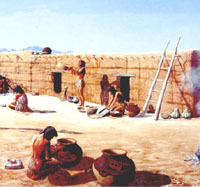
A potter paints designs on a large
El Paso Polychrome jar. The painting was done after
the vessel was dried and polished, but before it was
fired. Mural by George Nelson, courtesy of the artist
and the Institute of Texan Cultures.
Click images to enlarge
|

Restorable bowl from fill of Room
25. It is El Paso Polychrome, hallmark of the El Paso
phase (or Pithouse period) of the Jornada Mogollon.
|

Large sherds of El Paso Polychrome,
jar (left), bowl (right). The rim sherds from the site
showed that jars outnumbered bowl by 4 to 1. In part
this probably reflects the fact that the site was not
located near any known source of water.
|
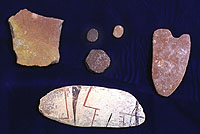
Worked sherds. Center, gaming or
counting pieces; left, paint palette; bottom, pottery
smoother made on sherd of Casas Grandes tradeware; right,
pottery jar rim template or shaper.
|
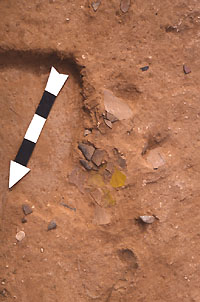
Pottery-making tools on the floor of Room 26, including
sherd paint palettes, paint, polishing pebbles, and unfired
clay bowl (bottom center).
|
|
Pottery is the most common and often the most
informative artifact category at Jornada Mogollon sites. Whole
pots or even reconstructable ones are rare. Mostly what we
find are thousands of sherds: pottery is fragile, and all
it takes is one slip and a nice pot becomes a pile of sherds.
But this works out nicely for archeologists—the sherds
can tell us what kind of pottery it is, where it is from,
what kind of vessel it is, as well as something about disposal
patterns. Most sherds wound up in trash heaps, but others
were left where the pots were dropped.
El Paso Polychrome makes up over 90% of the
ceramic material from Firecracker Pueblo and is typical of
the late El Paso phase. Jars outnumbered bowls by approximately
four to one. Less common vessel forms are pitchers, ladles,
and "terraced-rim" bowls. Whereas in earlier Jornada
Mogollon sites the undecorated El Paso Brownware pottery is
often the most common type, the only undecorated piece of
local manufacture at Firecracker is a small pinch bowl (a
bowl formed simply by inserting a thumb into a wad of clay
and pinching the clay against the palm—something a child
might do).
In addition to the locally produced wares, there
are many sherds of tradewares including Chupadero Black-on-white,
Gila Polychrome, and polychromes and other wares of the Casas
Grandes culture. These types would not be unexpected for a
site dating to the fifteenth century. However, there are sherds
from other pottery types thought to have been made centuries
earlier such as Mimbres Black-on-white. These sherds could
have been picked up at abandoned sites nearby or perhaps represent
heirloom pieces.
Pottery is also helpful in examining distribution
patterns within sites. One major question at Firecracker is
the time difference between the pithouse and pueblo occupations.
To help answer this question we looked to see if there were
any differences in the pottery types and forms present in
each area. An analysis of 1,037 rim sherds (which are more
informative and varied than body sherds) of El Paso Polychrome
found no significant differences between the rim attributes
of the pithouse and pueblo occupations, suggesting that these
are very nearly contemporaneous.
Pottery Making
With so much pottery it is only to be expected
that pottery making was a common activity at Jornada Mogollon
sites. And ample evidence of this was found at Firecracker.
The best evidence is the finding of pottery-making tools,
small deposits of unfired potter's clay, and an unfired and
unfinished pottery bowl. Unfired potter's clay from one of
the pithouses was matched to a clay bed not far from the pueblo,
suggesting that El Paso Polychrome was being made at Firecracker.
Pottery-making tools were found lying on several floors of
both pueblo and pithouse rooms; perhaps the potters intended
to come back or maybe pottery tools were easy enough to find
or make.
Many kinds of pottery-making tools were recognized
at Firecracker. Half-rounded and smoothed potsherds were probably
used as shaping and smoothing tools. Round disks of pottery
probably served as platforms or "dishes" upon which
pots were built; the round bottom of the sherd helped shape
the bottom of the new pot and it allowed the potter to rotate
the pot as she worked on it. (She? Numerous ethnohistoric
and ethnographic accounts in the Southwest show that pottery
was ordinarily made by women.) Small smooth pebbles were probably
used as polishing stones after the "green" pot was
mostly dried, but before it was fired. A large sherd with
a rounded notch was probably used as a rim "template"
to help the potter shape and smooth the rim of flared-mouthed
jars.
The most interesting find of pottery-making
tools was in one of the pithouses, Room 26. In one area of
the floor of this room was a concentration that must have
been left by a potter. An unfinished and unfired clay bowl
shows work in progress. Several sherds form a paint palette
where the paint was mixed and held to decorate El Paso Polychrome.
We know this because some of the bright yellow limonite (iron
oxide) was still there. There were also polishing pebbles
in this cluster of things.
Adding up this evidence, it appears that
pottery making was a common activity at Firecracker Pueblo
as it probably was at most Jornada Mogollon residential sites.
Pottery was needed for storing drinking water, storing food,
cooking, and food serving, among other uses.
|
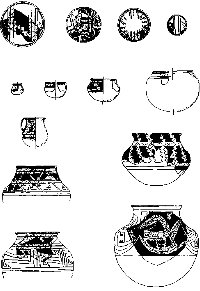
Drawings of reconstructed El Paso
Polychrome vessels found at Firecracker Pueblo.
|
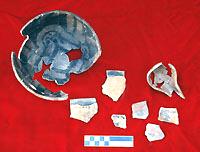
Restorable El Paso Polychrome bowl
from Room 25 with several of its rim sherds and a partial
gourd-shaped ladle from same room.
|
|
Unfired potter's clay from one of the pithouses
was matched to a clay bed not far from the pueblo, suggesting
that El Paso Polychrome was being made at Firecracker.
|
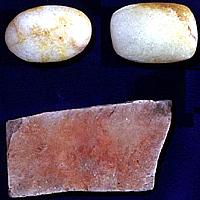
Paint palette and two polishing pebbles. |
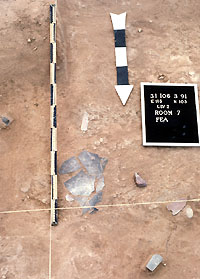
Pottery-making tools on the floor of Room 7, including
a pottery jar rim template, a polishing pebble, and large
sherd dish or palette. |
|